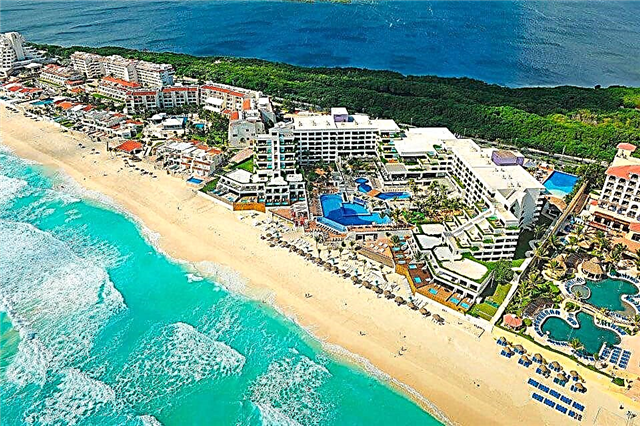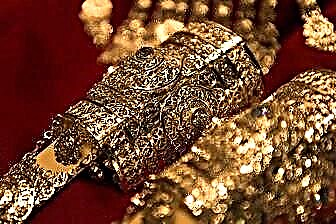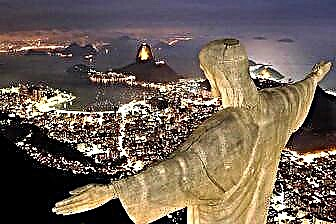Rio de Janeiro is a splendor of bright colors and an eternal carnival, ocean and endless sun. The city is located on the shores of Guanabara Bay, and is one of the most beautiful in South America. Nature has generously endowed this area, the Brazilians believe that such beautiful lands were granted to them by the Lord himself. It seems as if the inhabitants of this city always have a holiday accompanied by the incessant sounds of samba.
Who has not dreamed of climbing to the top of Mount Corcovado and looking at Christ the Redeemer or plunge into the emerald waters of the Atlantic at the famous Copacabana? Dreams come true in Rio de Janeiro. The elated state of mind is mixed here with the expectation of danger from gloomy favelas, and a slight dizziness from caipirinha with gentle nights. All this is Rio.

The best hotels and hotels at affordable prices.
from 500 rubles / day
What to see and where to go in Rio de Janeiro?
The most interesting and beautiful places for walking. Photos and a short description.
Statue of Christ the Redeemer
The huge 38-meter monument is the main and most recognizable symbol of Rio de Janeiro. It was installed in the first half of the 20th century on the Corcovado mountain, which rises about 700 meters above the city. The observation area of the statue offers a stunning view of the bay, rugged by green hills. At any time of the year, an impressive line of tourists is lined up, wishing to climb to the statue of Christ the Redeemer with outstretched hands.

Sugar Loaf
Mountain up to 400 meters high, which is located within Rio de Janeiro. The observation decks and a small park at the top rival the statue of Christ the Redeemer in popularity. You can climb Pao di Asquar (as the name sounds in Portuguese) using the cable car. The name "Sugarloaf" was given because of the resemblance to a special container of the same name, in which the Portuguese brought sugar from Brazil.

Municipal Theater
The theater was built at the very beginning of the 20th century and immediately became an adornment of Piazza Floriano. The architecture of the building clearly shows a mixture of styles - eclecticism. During the construction, the building of the Paris Opera was taken as a model. Famous foreign collectives often perform on the theater stage, the local choir, symphony orchestra and ballet troupe are no less popular.

Portuguese Royal Library
The luxurious building in the Portuguese Manueline style was erected in the period 1880-1887. The library was founded with the aim of popularizing the culture and values of the metropolis in the territory of the Brazilian Empire. The foundation stone was laid by Emperor Pedro II. Many architectural elements of the building follow the outlines of the famous Portuguese palaces, monasteries and cathedrals.

Tiradentes Palace
An early 20th century building erected for administrative purposes. The Legislative Assembly sat in it. Earlier, on the site of the palace, there was a prison where the national hero and fighter for the independence of Brazil, Joaquin Jose da Silva, died. The interior of the palace is decorated with paintings by Brazilian painters, French mosaics and carved wooden furniture in the Portuguese style.

Ilha-Fiskal Castle
The castle is located on an island in the Guanabara Bay off the coast of Rio de Janeiro. It was built in 1889 for the needs of the Customs Service, but outwardly resembles, rather, the residence of royalty. Inside is the Historical Museum of the Brazilian Navy. A mixture of styles is used in the architecture of the castle. The decorative elements were brought from England, Germany and other European countries.

Celaron's staircase
Multi-colored 125-meter staircase, created by the Chilean artist Jorge Celarón. The master has been creating step by step since 1990. Gradually, this small cultural project grew to the scale of an obsession, and as a result, a long staircase was formed. For the facing of the handrails and steps, several thousand tiles were used, brought from different countries and found in garbage cans.

Church of Candelaria
It was once the largest and most magnificent temple in the Brazilian Empire. According to one version, it was founded by Spanish travelers in 1609 after they managed to escape a terrible storm. Until the 18th century, it was a simple wooden chapel. Then a stone temple was erected in its place under the leadership of F. João Rocio. The opening took place in 1811 in the presence of the Portuguese king João VI.

Cathedral of Saint Sebastian
The main Catholic church of the Brazilian capital, which is located in the historic center of the city. The cathedral was opened in 1979, it was named in honor of the patron saint of Rio de Janeiro - Saint Sebastian. Outside, the temple resembles an Indian pyramid and, at the same time, a futuristic structure from science fiction. In the underground part of the temple there is a museum and a crypt where famous personalities are buried.

Monastery of Saint Benedict
Benedictine monastery, founded at the end of the 16th century thanks to the intercession of local residents. The building of the monastery was erected in the Baroque style. The external facade is distinguished by modest forms and a small number of decorative elements. The interior, on the contrary, is executed with special splendor - burgundy walls, multi-colored mosaic floors, gilded molding, an abundance of paintings and sculptures decorate the interior.

Rio de Janeiro Botanical Garden
The garden covers several hundred hectares of land and is located in the southern part of the city. It was founded in 1808 at the behest of the royal family. Amazing exotic plants from all over the world were brought to the garden, which quickly adapted to the local climatic conditions. At the moment, more than 7 thousand representatives of the fauna grow here. The territory has ponds, fountains, palm alleys and themed areas.

Flamengo park
A large green area inside the city, over which the landscape designer R. Burle Marx worked (he also worked on the appearance of the Copacabana beach promenade). Various sports competitions are held on the territory of the park: bike rides, marathons and others. At any time of the day, you can see the townspeople doing sports or just relaxing on the green lawns and benches.

Enrique Lage Park
The park is located at the foot of Corcovado on an area of 52 hectares. In the central part is a charming mansion that once belonged to the family of the industrialist Enrique Lage. The park and palace acquired their modern look in 1920 thanks to the work of the architect M. Vodrell. The outer walls of the building are faced with Italian marble, specially delivered from overseas, the walls are decorated with works by Salvador Payals.

Carioca Aqueduct
The building is located in the picturesque suburb of Rio de Janeiro, the Santa Teresa area. The bridge was built right in the center of the city at the beginning of the 18th century. The construction was supervised by Portuguese military engineers. It was assumed that the Carioca aqueduct will be able to provide water to 3 settlements. The plumbing was no longer used by the end of the 19th century, making it a bridge for public transport. The aqueduct offers a rather picturesque view that attracts many tourists.

Maracanã stadium
The main stadium of Brazil and the symbol of the "most football" country in the world. More than once, Maracana has become an arena for grandiose sporting events. In 2016, the opening and closing of the XXXI Summer Olympic Games took place here. The stadium was built in the middle of the 20th century. At that time, it was the largest football arena in the world. After the last reconstruction, Maracana can accommodate up to 80 thousand spectators.

Favelas
A group of urban slums that occupy a large part of Rio de Janeiro and give city authorities a lot of trouble. In fact, Brazilian favelas are a whole world, a separate and independent subculture and "state within a state." The inhabitants of these areas are practically autonomous. They almost do not pay for utilities, many are engaged in drug trafficking and other criminals.

Rodrigo de Freitas lagoon
A picturesque bay that is connected to the Atlantic Ocean by a narrow channel. It is a popular vacation spot for the townspeople. Families and large companies often come to the lagoon. Unfortunately, the water in the bay is not clean, but you can safely use the developed infrastructure on the shore, ride a boat or play beach volleyball. There are free gyms and playgrounds on the territory of Rodrigo de Freitas.

Copacabana beach
Rio de Janeiro city beach, 4 km long. along the coast. From 50-60 years. elite residential areas began to be built here, and the place became popular with European bohemians. The Avenida Atlantic embankment stretches along the beach. Copacabana is visited by millions of Brazilians and tourists every year, and many public holidays take place on the beach, including the New Years.

Ipanema beach
Another famous Rio de Janeiro beach surrounded by upmarket areas. Ipanema is adjacent to Copacabana, but it is considered safer than the latter, as it is located further from the area of disadvantaged slums. Despite the large number of visitors, the water here is considered clean (depending on the season). There are also fewer ocean waves in the Ipanema area, so it is preferred by families with children and older people.

Carnival in Rio de Janeiro
An annual holiday, a real extravaganza of colors, feelings, rhythm and all the joys of life. The Brazilian Carnival has long been considered an intangible heritage of humanity. Thousands of professionals from various samba schools parade at the sambodrome, a street with stands specially designed for such events. Dancers compete in skill, beauty of costumes and scale of scenery.












